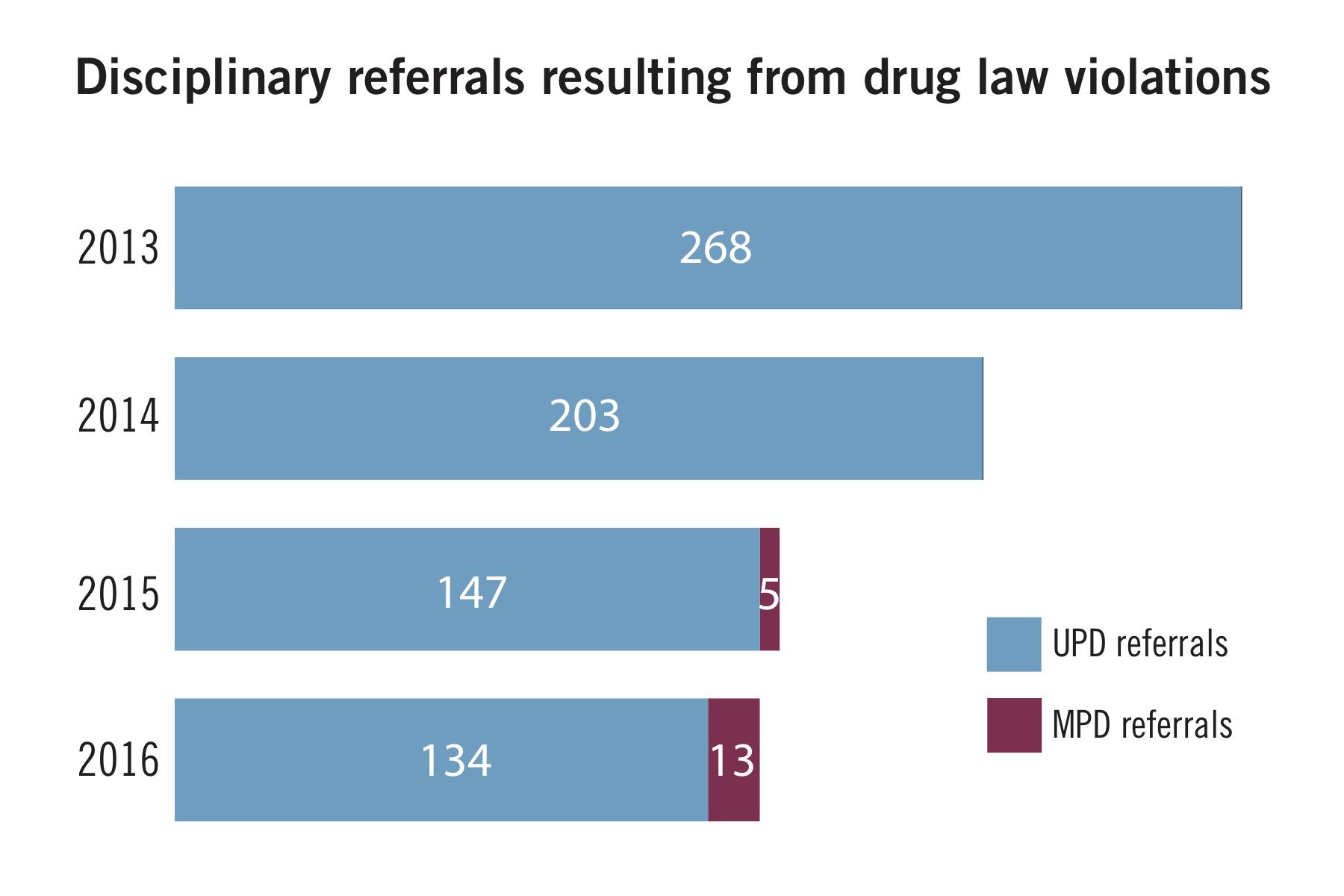
MaryGrace Arnold | Hatchet Designer
Source: University Security Report 2017
In the past four years, the number of disciplinary referrals for drug law violations on the Foggy Bottom Campus has plummeted by nearly half.
GW documented 147 drug law referrals on the Foggy Bottom Campus in 2016 – about a 45 percent drop from the 268 recorded in 2013, according to annual security reports, the most recent of which was released Friday. The University’s top security official credited drug education programs for the decrease, but experts said a change in drug enforcement could explain the significant drop.
GW defines drug law abuse as producing, distributing and using controlled substances or devices used to prepare or take illegal drugs. A drug violation referral does not result in an arrest, but it typically sends offending students to the Office of Student Rights and Responsibilities to be sanctioned.
Darrell Darnell, the senior associate vice president for safety and security, said the decline in violations could be attributed to effective University drug education programs. He said the decrease in drug violations was the most “satisfying” change in the security report this year.
“I think it’s part of education and outreach that we do, trying to educate students on using illegal drugs and again the fact that more students have decided not to do that – it’s not any policy change on our part and how we enforce the law,” he said in an interview.
During the last academic year, the Division of Student Affairs hosted 82 programs on alcohol violations, fire safety, personal safety and crime prevention. The University Police Department has also staged about 200 crime prevention and general security and safety awareness presentations, according to the report.
The Health and Emergency Management Services – a branch of the safety and security division – held 39 educational programs last academic year and offers surveys and meetings where students can evaluate their use of alcohol and drugs, according to its website.
The federally mandated annual security report – released each September – analyzes the number of reported crimes on each of GW’s campuses over the past three years.
The referrals include cases handled both by UPD officers and the Metropolitan Police Department. While drug referrals handled by UPD have decreased, referrals involving MPD have jumped from zero in 2014 to five in 2015 to 13 last year, according to the security report.
Darnell attributed the jump in MPD referrals to student confusion regarding marijuana drug law changes in D.C.
Marijuana was decriminalized in D.C. beginning in 2014, but officials have continued to follow federal laws banning the use and sale of the drug, despite the city’s action.
“Some students just don’t understand what the distinction is, and they just find themselves in a difficult situation,” he said.
Usually, referrals to MPD occur when students are found to be in possession of more marijuana than allowed under D.C. law, he said. People over age 21 can only possess up to two ounces of marijuana in the District.
Drug violation referrals on the Mount Vernon Campus have also dropped by more than 80 percent in the last year. Referrals decreased from 21 in 2015 to four last year, according to this year’s security report.
Previously, the referrals on the Mount Vernon Campus stayed between 19 and 21 violations each year between 2013 and 2015. All of the violations were reported to UPD, according to the security report.
While referrals to SRR continue to decrease, arrests for drug use on the Foggy Bottom Campus rose from six in 2015 to 11 in 2016. The increase brings the drug arrests back to the level they were in 2014. UPD made all but one drug arrest in 2014, but since then, city police have made every drug arrest, according to the report.
Experts said generally at universities, a decrease in the number of drug referrals means police are encountering fewer drug cases, but not necessarily that illegal drug use is decreasing. Local drug law changes can also impact the number of referrals, they said.
Over the summer, the University announced that students who allegedly violated alcohol and drug policies could now enter a GW-sponsored recovery program instead of facing SRR sanctions.
Aran Mull, the deputy chief of police at the University of Albany, said the best case scenario is that a university has made efforts to discourage drug use through police or university enforcement of anti-drug policies.
“That makes everybody safe, that makes everybody better and frankly makes people more likely to be successful at their college career,” Mull said.
Other universities in D.C. have not seen nearly as sharp of a decline in drug law referrals. At Georgetown University, the number of referrals decreased from 42 in 2015 to 30 in 2016. The previous year 23 were documented, according to its security report.
Similarly, at American University, judicial referrals for drug use dropped to 116 last year from 121 in 2015. In 2014, American counted 80 drug abuse violations resulting in referrals, according to its security report.
Narcotic violations have plunged District-wide, from 9,688 in 2011 to 2,513 in 2015 – a decrease of 74 percent, according to the last available data in MPD’s annual security reports.
Alfred Blumstein, an emeritus professor of urban systems and operations research at Carnegie Mellon University, said most recent changes in drug referrals could be related to marijuana law changes or a result of increased police enforcement. Policy across the country has recently focused on efforts to curtail drug violations, he said.
“There’s no question that’s much more an indication of choices by police of what they’re going to do, rather than an indication of what’s going on in the world about drug violation, drug activity,” he said. “It’s not a violation until the police detect it and do something about it.”
S. Daniel Carter, the president of Safety Advisors for Educational Campuses, LLC, said he would expect a change in handling procedure or an environmental factor like the opening of a new residence hall to affect drug referral numbers.
“I have not seen any indication in drug violation in that significant a number nationally,” he said. “But there’s always instances where factors change on individual campuses.”
Riya Gavaskar, Jackie Torrez, Meredith Roaten and Cayla Harris contributed reporting.




